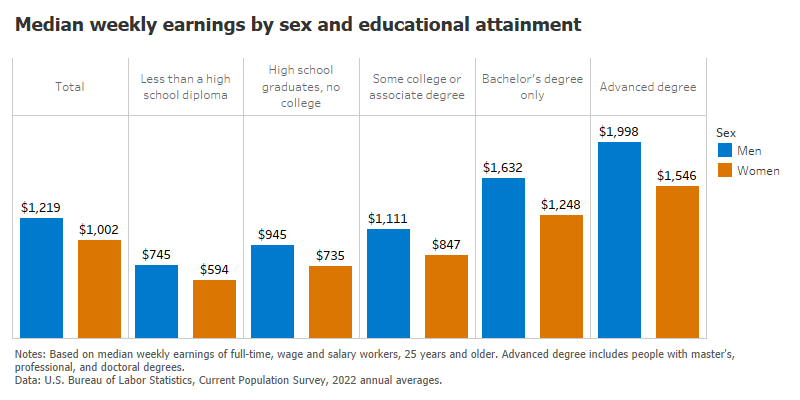En Español

March 14 is Equal Pay Day. Here are five fast facts about the gender wage gap.
- Stats. Overall, women are not paid as much as men, even when working full time and year round. On average, women working full time, year round are paid 83.7% of what men are paid. This inequity is even greater for Black and Hispanic women.
- Causes. Women’s labor is undervalued. Most of the disparity in women and men’s pay cannot be explained by measurable differences between them. Out of the causes of the wage gap that we can measure, the main contributor is that women are more likely than men to work in low-paying jobs that offer fewer benefits.
- Education. Education is not enough to eliminate the gender wage gap. On average, women have more years of education and are more likely than men to have completed Associate’s, Bachelor’s or Master’s degrees. Yet there is a significant gender wage gap at every level of education. Overall, women must complete one additional degree in order to be paid the same wages as a man with less education.
- Age. The gender wage gap does not resolve itself as women age and develop further in their careers. In fact, the wage gap for older women workers is larger than for younger women, and older Black and Hispanic women have the most extreme differences in pay.
- Occupations. The largest identifiable causes of the gender wage gap are differences in the occupations and industries where women and men are most likely to work. Women are 2 out of every 3 full-time workers in occupations that pay less than $30,000 per year, and fewer than 1 in 3 full-time workers in jobs paying an average of $100,000 or more. However, even within the same occupations, women earn less on average than men.
Learn more about equal pay in the United States.
Wendy Chun-Hoon is the director of the U.S. Department of Labor’s Women’s Bureau. Follow the agency on Twitter: @WB_DOL.
Brecha Salarial por Género: 5 Datos

El 14 de marzo es el Día de la Igualdad Salarial. Consulte estos 5 datos sobre la brecha salarial de género.
- Estadísticas: En general, a las mujeres no se les paga tanto como a los hombres, incluso trabajando a tiempo completo todo el año. A las mujeres que trabajan a tiempo completo durante todo el año se les paga como promedio el 83,7% de lo que a los hombres. Esta inequidad es aún mayor para mujeres Negras e Hispanas.
- Causas. El trabajo de la mujer está infravalorado. La mayor parte de la disparidad salarial no puede explicarse por diferencias medibles entre hombres y mujeres. De las causas que sí podemos medir, el principal contribuyente es que las mujeres tienen más probabilidades que los hombres de trabajar en ocupaciones mal pagadas y con menos beneficios.
- Educación. La educación no es suficiente para eliminar la brecha salarial de género. En promedio, las mujeres tienen más años de educación y son más proclives que los hombres a haber completado títulos de Asociado, Licenciatura o Maestría. Sin embargo, existe una significativa brecha salarial por género en todos los niveles educativos. Por lo general, las mujeres deben completar un título adicional para recibir el mismo salario que un hombre con menos educación.
- Edad. La brecha salarial de género no se resuelve por sí sola a medida que avanza la edad de las mujeres y crecen en sus carreras. De hecho, la brecha salarial para trabajadoras mayores es superior que para mujeres más jóvenes. Y las mujeres mayores Negras e Hispanas registran las diferencias salariales más extremas.
- Ocupaciones. Los mayores causantes de la brecha salarial de género son las diferencias en las ocupaciones e industrias en las que es más probable que trabajen mujeres y hombres. Las mujeres representan 2 de cada 3 trabajadores a tiempo completo en ocupaciones que pagan menos de $30,000 al año, y menos de 1 de cada 3 a tiempo completo en trabajos que pagan como promedio $100,000 o más. Sin embargo, incluso en las mismas ocupaciones, las mujeres en promedio ganan menos que los hombres.
Aprenda más sobre la igualdad salarial en Estados Unidos.
Wendy Chun-Hoon es la directora de la Oficina de la Mujer del Departamento de Trabajo de EE.UU. Siga a la agencia por Twitter: @WB_DOL.

 U.S. Department of Labor Blog
U.S. Department of Labor Blog